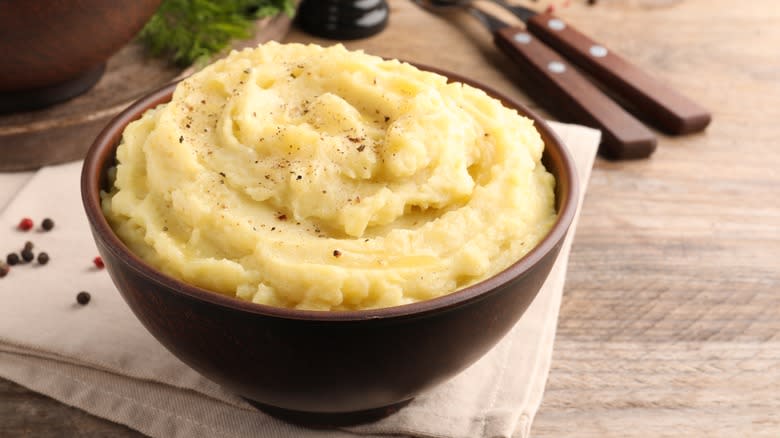What To Be Mindful Of When Making Mashed Potatoes In The Slow Cooker

Slow cookers always make things a little easier. Being able to throw ingredients in, set a dial, and step away from the kitchen means no babysitting pots of boiling water or having to skim or stir every so often — right? Though using a slow cooker does mean less active, hands-on monitoring, it doesn't always mean you can set it and completely forget it. This is especially true for making slow cooker mashed potatoes, which need to be checked on regularly to prevent milk caramelization.
If you're cooking potatoes for an extended period of time, caramelization or browning may happen, especially where the dairy comes in contact with the sides of the pot (where the heat is most intense). While this won't affect the taste of the final product (and may even impart a richer flavor), it will affect the appearance of the potatoes. So, if that matters to you, you'll need to come back and stir more frequently or remove the brown bits towards the end of the cooking time.
Read more: The Best Kitchen Gadgets You Can Buy
Why Does Milk Brown In The Slow Cooker?

When milk comes in contact with heat for an extended period of time, a process called the Maillard reaction occurs. Yes, this is the same Maillard reaction that gives us the crust on a seared steak, or the golden-brown appearance of a freshly baked loaf of bread. This transformation happens when amino acids and reduced sugars form a reaction together, typically under the influence of heat. The sugar in milk, called lactose, caramelizes — and what you're left with is browning.
Just be mindful — if milk is heated too much, the water in the milk will evaporate, and the milk will burn and form black carbon, which isn't very fun to eat.
Caramelized milk can be a delicious addition to mashed potatoes, as long as you don't mind the affect it has on the potatoes' appearance. To cause this reaction, cook the potatoes on high; when cooking the potatoes on low, the slow cooker may not get hot enough for caramelization.
More Tips For Better Slow Cooker Mashed Potatoes

Beyond minding the caramelization, there are a few extra considerations you might want to take when preparing slow cooker mashed potatoes. For potato variety, some swear by russet potatoes, which create a lighter, fluffier mash. Others use Yukon gold for mashed potatoes, leading to a heavier, denser mash. Depending on your preference, you could use either (or a mix of both, if you want some balance). However, in some cases, russet potatoes have been known to oxidize a little during the long slow cooking process. So if appearance matters to you, going with gold might be ideal.
Most recipes call for the potatoes to be cooked in milk in the slow cooker, with butter and extra milk added towards the end for mashing. For an even more decadent potato, add half and half or cream at the end instead.
Want extra garlicky flavor in your mashed potatoes? Toss a few smashed garlic cloves directly in with the potatoes while cooking. There's no need to chop them; while everything slow cooks, the garlic will soften considerably, and you can mash the finished product right in without resistance.
Read the original article on Daily Meal.


